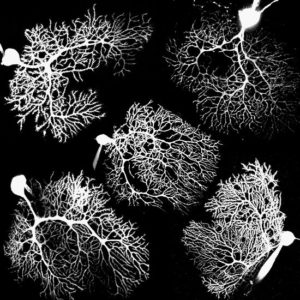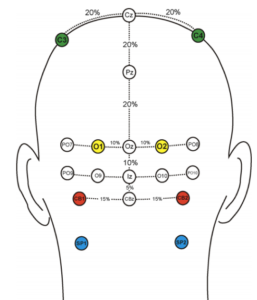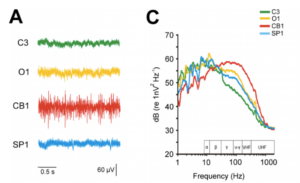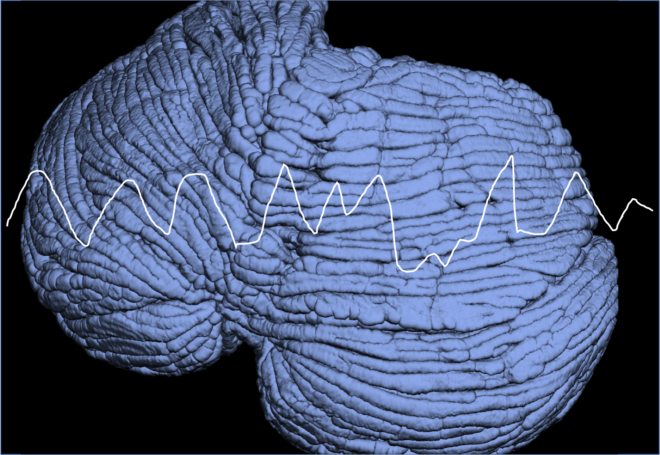The cerebellum has four times as many cells as the neocortex and possible roles in everything from movement to cognition and emotion but is much harder to study. Is it possible to measure EEG signals in the cerebellum?
The role of the cerebellum was previously thought to be largely restricted to motor coordination. More recent evidence suggests discussed in a previous blog post suggests that it likely plays a similar role in coordination of cognition and emotion by ‘organizing’ their elements – essentially making it crucial to all human function. The cerebellum has expanded substantially in human evolution and has four times the number of cells of the cortex – mostly tiny granule cells packed into a dense cellular layer within the cerebellar cortical ribbon [1]. Moreover, despite its relatively smaller volume the human cerebellum has 80% of the surface area of the cortex because of its extensive folding – compared to just 33% in monkeys [2]. It is increasingly being implicated in various neuropsychiatric disorders such as schizophrenia and ADHD, making an important case for study of the human cerebellum.
However its distinct position tucked partially under the posterior cortex makes it very hard to study in humans. Consequently, although there are some clinical studies of lesions and pathology in disorders, most of the understanding that we have of the cerebellum thus far comes from rodents. The ability to measure aspects of cerebellar function in humans in a noninvasive manner would thus be extremely valuable. The big question therefore is whether technologies like EEG can do this.
The Challenges of Detecting and Interpreting EEG signals from the Cerebellum
There have been a number of arguments put forth on why such measurement would not be possible.
Positioning of the cerebellum: First, the EEG signal has poor spatial resolution which makes it difficult to resolve signal from the cerebellum when it is partly obscured by the cortex. It is also positioned such that the distance to an external sensor may be greater creating greater signal diffusion and therefore a poor signal to noise ratio. Given this the 10/20 system for EEG does not specify a sensor placement suitable for measuring cerebellar signal – essentially at the nape of the neck. Some who argue that such electrode placement is problematic have even suggested measuring cerebellar activity by placing electrodes on the roof of the mouth to get to the cerebellum on the other side.
Structure of the cerebellum: The EEG signal arises essentially from a spatial and temporal summation of underlying electrical activ ity – both synaptic and spiking. It is thus thought that the more intricate folding of the cerebellum would result in the signal from one fold potentially cancelling out the signal from the neighboring fold if signals are of opposite orientation based on the fold position. Secondly, one of the rationales proposed for how the EEG signal is detectable is the laminar organization of pyramidal neurons in the cortex where all dendritic trees are directionally aligned. This leads more readily to coherent summation of activity on the surface. However, unlike pyramidal neurons, the dominant purkinje neurons in the cerebellum have immense treelike dendritic arborizations (Image: Composite of 5 purkinje neurons by Dmitry Sarkisov, Dept of Physics, Princeton University). Thus in addition to the folding, this dendritic structure in the cerebellum could also result in opposing orientations at different points and therefore signal cancelation. Source localization studies, which rely on this assumption of the manner of signal summation in the construction of the EEG signal, would therefore not be able to reliably identify cerebellar sources of signal. Altogether, any apparent signal from the cerebellum is most often thought to be artifactual.
ity – both synaptic and spiking. It is thus thought that the more intricate folding of the cerebellum would result in the signal from one fold potentially cancelling out the signal from the neighboring fold if signals are of opposite orientation based on the fold position. Secondly, one of the rationales proposed for how the EEG signal is detectable is the laminar organization of pyramidal neurons in the cortex where all dendritic trees are directionally aligned. This leads more readily to coherent summation of activity on the surface. However, unlike pyramidal neurons, the dominant purkinje neurons in the cerebellum have immense treelike dendritic arborizations (Image: Composite of 5 purkinje neurons by Dmitry Sarkisov, Dept of Physics, Princeton University). Thus in addition to the folding, this dendritic structure in the cerebellum could also result in opposing orientations at different points and therefore signal cancelation. Source localization studies, which rely on this assumption of the manner of signal summation in the construction of the EEG signal, would therefore not be able to reliably identify cerebellar sources of signal. Altogether, any apparent signal from the cerebellum is most often thought to be artifactual.
Measuring the Electrocerebellogram (ECeG)
First off, it is not that there is no signal at electrodes placed in cerebellar locations. From as early as 1964 there have been recordings of what is called the electrocerebellogram (ECeG) demonstrating signal across a wide range of frequencies [3, 4]. A more recent paper by Todd et al shows the power spectrum at cerebellar locations relative to other locations [5]. The cerebellar signal has a distinct power spectrum compared to the other sensor locations.


Figure (from [5]) shows cerebellar electrode placement (red), signal and power spectrum
Todd et al use an ANOVA to show that the signal at the cerebellar electrodes cannot be explained by a summation of activity at neighboring occipital and splenius electrodes. Thus evidence suggests that a relatively unique signal can be recorded at cerebellar regions. The question is how to interpret the signal in a way that is useful.
Utility and Interpretation of the ECeG Signal
Certainly any kind of source localization efforts will be a far stretch to accomplish. The more complex structure of the cerebellum will require a great deal more maneuvering to understand electrically and even assumptions underlying the EEG of the cortex itself are only that – assumptions. That said, many have tried (mainly in MEG, not EEG) and reported findings mainly by using a beamformer approach, which are summarized in [6].
However, at this stage much can be explored at the sensor level. As a first effort, the question would be whether the distinct power spectrum is generally reproducible by multiple groups at those electrode positions and whether it is modulated by changes in behavior. Second, it would be easy to test initially if other single channel features of the signal such as entropy and complexity measures can be related to any external behaviors/ tasks. Any kind of phase synchronization or coherence type of approaches to establish connectivity between EEG sensor activity and ECeG sensor activity on the other hand will not likely be relevant since the signals are constructed differently. However synchronization across bi lateral cerebellar sensors may yield results.
All said, the first step is for more people to include sensors at these locations in their measurement.
References
[1] Van Essen et al, Development and Evolution of Cerebral and Cerebellar Cortex, Brain, Behavior and Evolution, 2018
[2] Sereno et al, The human cerebellum has almost 80% of the surface area of the neocortex, PNAS July 2020
[3] Retif J Study of The Spontaneous Electric Activity of The Human Cerebellum. Acta neurologica Belgica August 1964
[4] Niedermeyer, E The Electrical Activity Of The Cerebellum: S115 Journal of Clinical Neurophysiology: October 2005
[5] Todd NPM et al The human electrocerebellogram (ECeG) recorded non-invasively using scalp electrodes, Neuroscience Letters Aug 2018
[6] Anderson et al., Can EEG and MEG detect signals from the human cerebellum Neuroimage, July 2020


Excellent!
Very Nice presentation. I have made recording from 30 subjects while walking and running for a major shoe company. I have precise timing from a force plate and high speed camera. We were able to localize slow potentials coming from the cerebellum with 76 electrodes placements in a manner similar to your derivation. The largest effects are in the infra-slow frequencies. The timing of these timing precedes motor potentials.
Unfortunately that is all I can tell you until I get a release.
That is awesome, Stephen!
Can’t wait to read the outcome of the study.